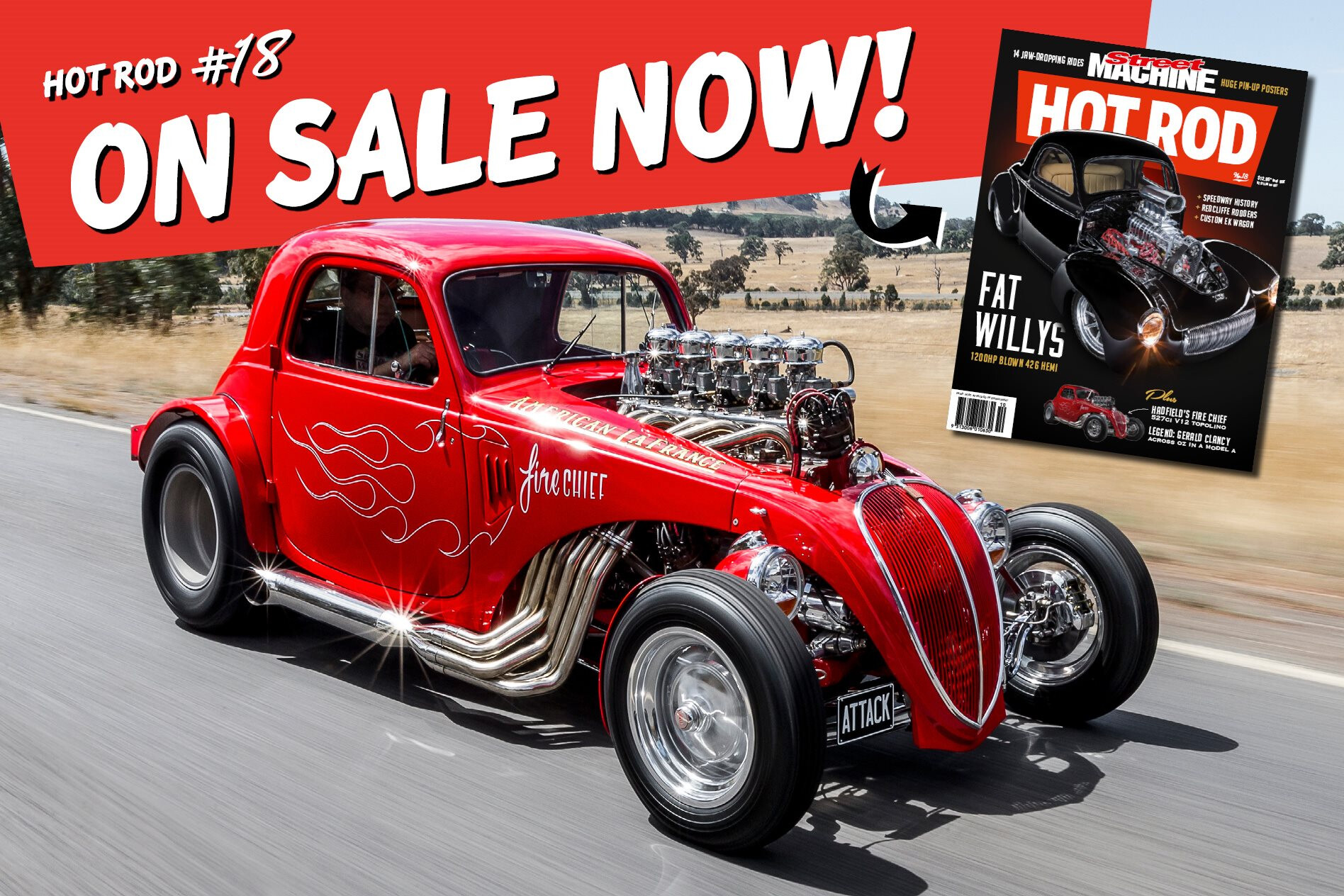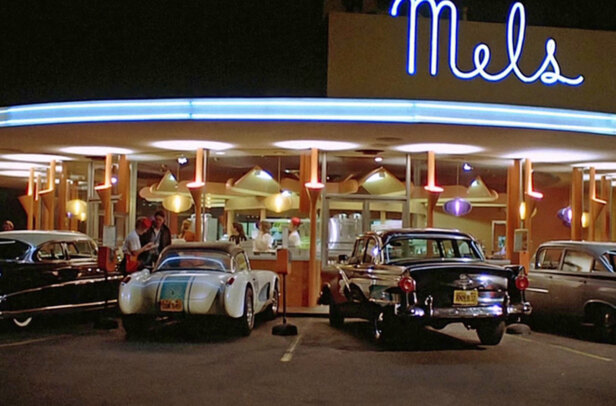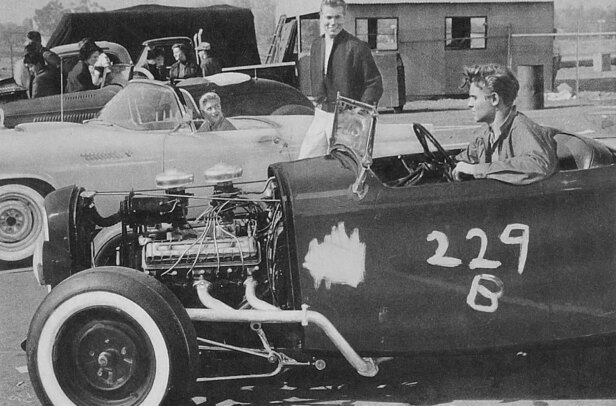This article – really just a record of a bunch of blokes sitting around reminiscing – is not meant to be a comprehensive history on the West Aussie hot rod scene. It’s a snippet of what was happening in one particular suburb of Perth in the late 50s when a bunch of kids discovered hot rods. I for one had no idea that it was happening so early, having assumed that it all started more towards the late 60s when the first hot rod clubs were forming.
These blokes are all in their mid-70s now, but there was one young kid who was about five years younger and hung around these crazy hot rodders. He gave me a handwritten letter briefly describing the early days as he recalled it. I couldn’t have said it better, so here it is.
Hot rodding or street rodding in Western Australia had its start in Central Avenue, Redcliffe. Can you imagine a suburban street having three families, all with the surname Marshall, all living side-by-side and all having sons the same age? There was Billy Marshall, an apprentice instrument maker; Brian Marshall, an apprentice sheet-metal worker; and Robert Marshall, an apprentice panel beater. Bill’s father allowed Billy and all his friends the use of a large shed in his backyard, while Robert had the use of a large mechanical workshop behind the local Mobilgas service station.
In 1957 Billy went to the movies and saw Elvis Presley delivering newspapers in a hot rod roadster and instantly wanted one. Within a few weeks he had located a sad ’32 V8 roadster that was being set up to road-race at Caversham Motor Circuit. But the owner had gone cold on the project, so Billy dragged it home.



With the help of others of the same age in Redcliffe, the car was on the road in a very short time. It helped that it was still registered for road use. A few months later, John Leopold from Victoria Park had his hiboy ’34 roadster on the road, while Brian Marshall had bought a ’34 roadster and was into channelling it and fitting cycle guards. He had most of the bodywork completed when he passed the project on to Graeme Selby, who completed the car. Graeme lived in Bulong Avenue, Redcliffe and was an apprentice electrician.
John Leopold had a hot ’42 Mercury engine in his ’34 roadster – cam, twin carbies and Edelbrock heads – but he managed to tip it over. This gave Billy the opportunity to acquire John’s motor for his ’32. In this form the car was one of the quickest in Perth.
So, it all began in Central Avenue, Redcliffe, and hot rodding took off, withrods turning up all over the place. The late 50s and early 60s were alive and happening, and we were lucky to be able to claim to be on the road first.
Mick Thompson
First published in Street Machine’s Hot Rod magazine #18, 2017

There are some pretty wild shots of you racing speedway, Billy. How did that all start?
Billy: Robert bought the ’34 [Ford coupe] plus a big sedan to make a hot rod, I suppose. Then we found out what was going on at Forrestfield Speedway, so we finished taking the body off the sedan and putting the ’34 on it, and made that up to race at Forrestfield. It was all Robert’s gear, but everyone had done a bit of everything on it.
Mick: Bill’s going to pay Robert one day. It was a heap of shit and we had to throw it down the tip.
Robert: I suppose I’ll get a bill for the trip down to the tip?


What was the ’32 roadster like when you got it?
Billy: It was pink all over, hand-painted. I took all the paint off straight away and repainted it grey. Someone had cut the back section out and dropped it down, but that was it. No seats, no radiator mounts or anything, just a heap of pieces.




So it was already channelled?
Billy: I was just copying what I saw in hot rod books, and because the radiator had to go forward to go low, I put a ’32 Dodge bonnet and side panels on it, but it had no floor in it. I got the seats out of a ’34 Ford and I cut the grille down eight inches too, because it was channelled eight inches. It had the original ’32 V8 in it when I got it.

Did you hop that up at all?
Billy: No, I didn’t hop it up at all. I just took it out and put a Mercury motor in it.
Brian: A ’42 Merc.
Billy: Yeah, a ’42 Merc. Then eventually I had a ’48 Merc hotted up and put in.
Mick: Not ordinary Mercurys; they’d been ported and relieved and all that sort of stuff. They were hotties.


What colour did it end up getting painted?
Mick: Gulfstream Blue, mainly.
Billy: But at the finish it was iridescent red.
Mick: Yeah, terrible colour.
Billy: You couldn’t get iridescent red, only on pushbikes, so I went to Davison Paints and they said: “We can make you some but it will only last a year and fade away.” So I thought, at least I’ll get a year out of it.




So you really wanted a candy apple red?
Billy: You could get some stuff like that from America, but it was probably £20, just out of the question. It was pretty rough, like the floor had bits of timber with old bits of tin and that. If you wanted something – like I found the front crossmember was cracked – you went straight down the tip. There’s an A-model down there; it was probably an hour-and-a-half down the tip with a cold chisel and hammer cutting all the rivets off. Even when we were racing the hot rod, Mick would go down the tip and get tyres and that.
Mick: The rubbish dumps were a great source of parts. You could race a car sourced from parts from the Belmont Tip!
Billy: The motor I had in it when I sold it was the best motor I ever had.
Mick: That thing still holds the outright standing quarter-mile record at Caversham. It’ll stand forever, 14.1.
Billy: I thought it was 15.7.
Mick: No! 14.1.

What about this ’34 Ford roadster, Brian? That was your first car?
Brian: I was 17 when I got that.
What was it like when you first got it? Was it already channelled?
Brian: No, it was a full-height car, mud guards, running boards.
It was a popular thing to channel a car back then.
Brian: It was only natural; they looked too high once you took the guards off. The rear fenders on the car were made out of Volkswagen guards. Have you heard of a fella called Cliff Byfield?

Hell yeah! He’s an amazing metal man.
Brian: He made those guards. He used to live across the road from me when I was a kid and he used to work in his workshop on the corner.
He’s about 90 now and still playing with cars.
Brian: He was a beautiful tradesman that man, a coach-builder. He built half the race cars in Perth! He used to make all his own chrome strips, headlight rims, all by hand.
Mick: He still does!
Some of these old speedway photos look pretty scary. How crazy was it?
Mick: The rule was, you had to have a seatbelt in the car, but it was optional whether you used it.
Billy: A lot of the blokes never wore seatbelts because they reckoned you had more chance of surviving without them. You never had any rollbars or anything; you’re sitting there and if that car keeps rolling over it squashes you, but if you can get thrown clear you’ve got more chance.

Getting back to your roadster, Billy, when did you get it on the road?
Billy: I was 17, so it was late ’58. I just kept the registration up.
Brian: That’s why I think the ’34 was the first car registered as a hot rod when Graeme got it licensed.
Mick: It was the first one that went over the pits at Bronte Street. They didn’t know what it was so they licensed it as a Ford Special.
Billy: The ’34 was the first car to be licensed as a hot rod, but I don’t even know if mine was the first hot rod on the streets. When I got my hot rod going I used to go out with a girl called Rosa Thompson, she ended up marrying Ronnie West, but I hadn’t seen her for, I dunno, 50 years or something. I was at the hot rod reunion at his place and he said: “Have you seen Rosa?” I looked, instantly recognised her after 50 years and she came over. She remembered when we used to go out, we’d go to the beach and you’d never get in the water, because as soon as you stopped heaps of people were there. No matter where you stopped, there were a million people there straight away.
Brian: That’s why she left you, because you wouldn’t go in the water.
Billy: No, she wanted to get engaged and I said I had to get some tyres for my street rod. I had to get the 6.00×16 winter treads on the back retreaded. You couldn’t get any good tyres, didn’t have any money in any case, but at the drags the winter tread tyres would bark like a dog when you took off.

[Billy then pulls out an absolute cracker of a photo.]
Billy: There’s a picture of you here with my hot rod when we first got it going, Brian, at Yallingup Beach. Notice the exhaust pipes coming out of the body? Oh, it used to sound nice, especially when you were going down into Meelup; you’d put it in second gear and let it burble. I had to shift them because we burnt someone’s hand.
Brian: When he never had the roof on there, we’d sit on the back of it, where the roof would fold down, with our feet behind the seat and lay down over the boot and hang on to the back bumper bar while he was going down to Meelup.
Billy: Remember we were going down one night and Johnny Leopold said he’d catch up with us. We were going along and he came up behind us bumping his front tyre up against the bumper bar and he wiped one of those ‘WA-made’ stickers off the bumper bar. Then he came up and put the handle bars in the door and we were sitting on 80mph!

What kind of bike was he on?
Brian: It was a BSA with a Triumph motor or the other way around. I remember he said he was coming down but he had to fix the bike up, so he went home and put a new motor in and caught us on the Berger’s Straight [a 10-mile-long straight heading south out of Wokalup] and stayed with us for the weekend. God he used to be mad!

Getting back to the hot rod, it had flared hinges. Did you do that?
Billy: I don’t know whether I did that or not. Do you remember, Robert?
Robert: No, I don’t think we did. I remember filling in the boot, welding all that up and lead-wiping it all.
Billy: Over the years it changed a lot. Years later – there’s not many photos of it – I had a white vinyl roof. When it was black I didn’t have any money, so I just got an army canvas roof, because that was the cheapest, and when it got scraggly I just got some black polish, a brush and painted it.

Did you ever cop much grief from the authorities?
Billy: They’d come to me and say: “You can’t do that.” I said: “Look, I’ve taken the mechanical brakes off it and put hydraulics on, so it’s better, and I’ve got a stop light, which originally they didn’t have to have.” The only reason they never used to worry too much was because everything we’d done was making it safer and it was still all Ford parts; it wasn’t homemade axles or dropped axles, it was all V8 parts. In those days when the cops picked you up they felt the steering for play, checked your tyres, they never worried about the exhaust much. The cops used to say you gotta expect a rod to make some noise, otherwise it’s not going to give the effect.
You weren’t afraid to drive it long distances, were you?
Billy: We’d go up and down to Busselton all the time. Go to Kalgoorlie, we used to go everywhere. I took my racing rod up to Kalgoorlie to race once and there were drags on. They said if you want to test your car out, the drag strip is the airstrip. So I went down to the airstrip and this plane kept swooping over me. Next minute this car comes pounding in and a bloke is yelling: “Hey, you can’t go there!” I said that’s where I was told I could test my car for the drags tomorrow. They said: “Yeah, but the bloody aeroplane’s trying to land!”
It’s even got a water bag. Shouldn’t it be on the front?
Billy: People used to say to me you’re supposed to have it on the front so that the wind goes through it, which keeps it cold. If we put it on the front and took the car up to 100mph, it used to squash the water bag, pop the cork and all the water would come out. So that’s why it’s on the back. Everyone had a water bag because motors were boiling all the time and it was good for drinking.
There’s a great series of photos where you crashed your speedway car.
Billy: I had the race won and Johnny Leopold’s motor was running sick, and we used to always be mucking around together, so I was pushing him into the last corner. Then I pulled out to pass him, I hooked my front wheel on the back of his car and bent the wheel around and I had no steering. It cost me the win!



That wasn’t the first time you crashed it. It had a Ford and then aTopolino body on it before that.
Billy: There was a place called Grasso’s Leap [at Forrestfield Speedway] and you never passed anyone there because it was too dangerous. I had the speed but no ability. I thought, bugger it, I’m going three-wide. Over the bank I went, end-for-end three times and then over sideways twice, and finished up underwater and someone dragged me out.
Mick: Len Christie.

So I guess we can thank Len Christie, wherever he may be, for dragging Billy out of the drink and giving him the chance to carry on telling his story, hang out with his mates and still have a great old time almost 60 years later!
REDCLIFFE RODDERS
- Billy Marshall
- Brian Marshall
- Robert Marshall
- Graeme Selby
- Mick Lloyd
- Les Donald
- Wally Bich
- Malcolm Hatwell
- Michael Thomson
All good mates helping one another and having a great time that cannot be forgotten. Still friends!



Comments